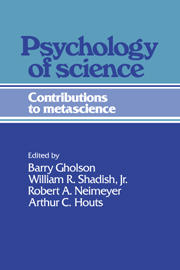Book contents
- Frontmatter
- Contents
- Preface
- Contributors
- 1 The psychology of science: An introduction
- Part I Historical issues in the psychology of science
- Part II The case for a psychology of science
- Part III Creativity and the psychology of science
- Part IV Cognition in the psychology of science
- 10 Cognitive paradigms and the psychology of science
- 11 Historical shifts in the use of analogy in science
- 12 Imagery, metaphor, and physical reality
- 13 A framework for the cognitive psychology of science
- Part V Social factors in the psychology of science
- Part VI Epilogue and Prologue
- Author index
- Subject index
10 - Cognitive paradigms and the psychology of science
Published online by Cambridge University Press: 05 June 2012
- Frontmatter
- Contents
- Preface
- Contributors
- 1 The psychology of science: An introduction
- Part I Historical issues in the psychology of science
- Part II The case for a psychology of science
- Part III Creativity and the psychology of science
- Part IV Cognition in the psychology of science
- 10 Cognitive paradigms and the psychology of science
- 11 Historical shifts in the use of analogy in science
- 12 Imagery, metaphor, and physical reality
- 13 A framework for the cognitive psychology of science
- Part V Social factors in the psychology of science
- Part VI Epilogue and Prologue
- Author index
- Subject index
Summary
If you sit down, elbows on a table, head between hands, covering your ears so that the noises of the room are cut off, you can hear a weak rumble. Especially if you give your hands the shape of a shell, taking the lobe and the pinna of your ear between your hand and thumb, and closing them gently against your head at the front side, it is as if you are hearing a waterfall at some distance. This is no illusory interpretation of some background noise. You are in fact hearing the fast current of a flowing fluid – the stream of your own blood. The circulation of the blood is a directly observable fact, apparently accessible to anyone who cares to listen. It even seems straightforward and is less ambiguous than the movements of the Earth and the Sun or the planets. There are no alternative interpretations. You cannot choose, as in the case of sunset, where you can perceive the Sun as moving slowly behind the horizon or the Earth as turning slowly away from the Sun. It is almost a case of direct perception, allowing no choice in interpretation.
The discovery of the circulation of blood was reported by William Harvey in 1628 in his De motu cordis, not as a simple matter of observation but as the outcome of a series of ingenious inferences and experiments.
Considering the familiarity of the domain and the relative unambiguity of the observation, it is astonishing that this discovery could take so long.
- Type
- Chapter
- Information
- Psychology of ScienceContributions to Metascience, pp. 275 - 295Publisher: Cambridge University PressPrint publication year: 1989
- 3
- Cited by



